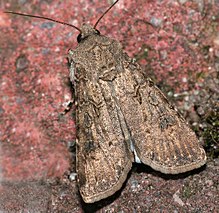Turnip Moth
| Turnip moth | |
|---|---|
 |
|
| Adult moth | |
 |
|
| Mounted | |
| Scientific classification | |
| Kingdom: | Animalia |
| Phylum: | Arthropoda |
| Class: | Insecta |
| Order: | Lepidoptera |
| Family: | Noctuidae |
| Genus: | Agrotis |
| Species: | A. segetum |
| Binomial name | |
|
Agrotis segetum (Denis & Schiffermüller, 1775) |
|
| Synonyms | |
|
|
The turnip moth (Agrotis segetum) is a moth of the family Noctuidae. It is a common European species, but it is also found in Asia and Africa, very likely having been spread by the international trade in nursery stock. It is a cutworm in the genus Agrotis, which possibly is the genus that includes the largest number of species of cutworms.
This is a very variable species with the forewings ranging from pale buff through to almost black. The paler forms have three dark-bordered stigmata on each forewing. Antennae of male bipectinated with moderate length branches. The main feature distinguishing it from other Agrotis species is the shade of the hindwings, pure white in the males, pearly grey in the females. The wingspan is 32–42 mm.
Two broods are produced each year, the adults flying in May and June and again in August and September. The species is nocturnal and attracted to light and nectar-rich flowers. The species overwinters as a caterpillar.
Agrotis segetum is one of the most important species of Noctuid moths whose larvae are called cutworms. The larvae are generally grey, sometimes tinged with purple. They attack the roots and lower stems of a huge range of plants (see list below) and can be a particularly serious pest of root vegetables and cereals. Attacking the lower stems often results in cutting down seedlings, which is why this species is classed as a cutworm.
The insect is not believed to be present in the United States, where the government has been making efforts to prevent its introduction on imported food crops. As with any other Noctuid, assorted diseases, predators, and parasitoids attack Agrotis segetum, mainly in the egg and larval stages, but not so effectively as to render control measures unnecessary. One major problem in dealing with infestations stems from the larvae's nocturnal habits, which make it more difficult to detect its presence in the first place, and more difficult to deal with anyway. Birds that will scratch it up, such as guinea fowl and other wild and domestic poultry can themselves not be tolerated in most of the crops that need protection; birds such as ibises and hoopoes, that probe for caterpillars, are not numerous enough. Insectivorous animals such as shrews, moles, and golden moles are regarded with suspicion by most gardeners, and also are generally too few.
...
Wikipedia
